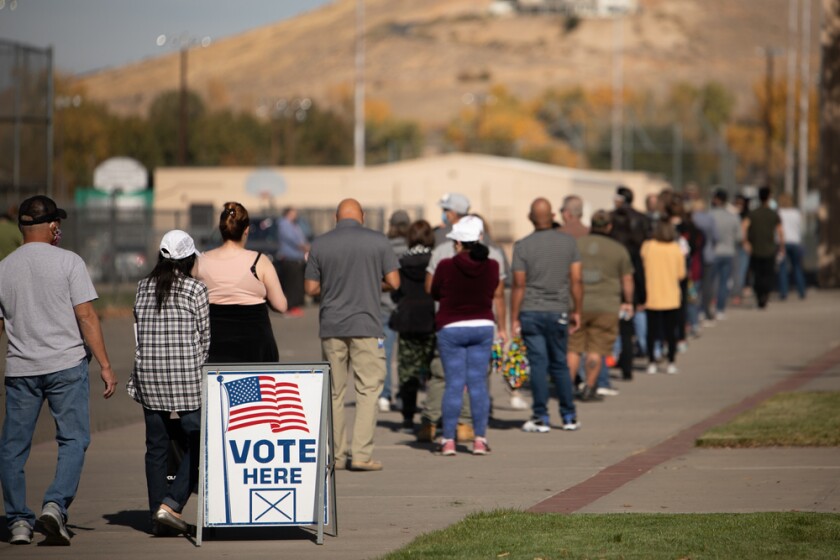Despite Democrats’ strong showing in one of the nation’s bluest states, though, Republican Gov. Phil Scott breezed to a fourth two-year term. In fact, Scott won by his biggest margin yet, scoring a massive 71 to 24 percent victory over Democrat Brenda Siegel.
If the gap in voting between governor and other offices was wide in Vermont, that was not unusual last month. Next door in New Hampshire, GOP Gov. Chris Sununu won re-election by a 15-point margin even as Democratic Sen. Maggie Hassan won by 10 points. Kansas Republican Sen. Jerry Moran cruised to re-election by a 24-point margin, but Democratic Gov. Laura Kelly nevertheless narrowly won a second term. And even in states where the same party won both major contests, including Arizona, Ohio and Pennsylvania, there was a decided difference in performance between candidates for Senate and governor.
“There’s obviously been more ticket-splitting in 2022 than in other recent elections,” says Gary Jacobson, a political scientist at the University of California, San Diego.
There are several reasons why more voters split their tickets for Senate and governor this time around. Incumbency played a role: Only one incumbent governor, Democrat Steve Sisolak of Nevada, was defeated. So did candidate quality. “In many cases, Republican Senate candidates were very weak and very inexperienced and not ready for prime time, and it showed,” says Whit Ayres, a Republican pollster.
Then there was the Trump effect. Many of the most prominent candidates whom former President Donald Trump endorsed for Senate lost close races, even as GOP governors such as Brian Kemp of Georgia, Mike DeWine of Ohio and Ron DeSantis of Florida won big after more or less keeping Trump at arm’s length. The American Enterprise Institute, The Economist and The New York Times all calculated that a Trump endorsement cost GOP candidates about five percent of the vote. “There was a Trump penalty at play in some of these races,” says Benjamin Melusky, a political scientist at Old Dominion University.
Melusky cautions that ticket-splitting has nowhere near returned to levels that were commonly seen between the 1960s and early 1990s. Most Americans are casting their votes for the same party for races all the way from state legislature to the presidency.
If Democratic Sen. Raphael Warnock wins Tuesday’s runoff against Republican Herschel Walker, 95 of the 100 senators would represent states that voted for their party for president in the last election. That would be an all-time record. Senate votes this year were correlated with previous presidential voting in states by the largest amount ever, Jacobson says.
In the U.S. House, only 23 members will represent crossover districts that voted against their party for president. That’s up from 16 in the current Congress, but still the second-lowest total in history. By contrast, there were 83 crossover districts in 2008, the year Barack Obama won the presidency. At the legislative level, there were only 314 crossover districts this year, out of 6,279, according to CNalysis, a forecasting group. That’s just 5 percent.
There aren’t that many voters splitting their tickets, but there may be enough left to swing close races. In Wisconsin, Democratic Gov. Tony Evers won his race by 3 percent, while Republican Sen. Ron Johnson held onto his seat by a single percentage point. “Wisconsin ticket-splitters may be an endangered species, but they’re not extinct,” says Mordecai Lee, a political scientist at the University of Wisconsin-Milwaukee. “There are just enough of them to determine election results.”
What Hurt Republicans
Republican performance was certainly disappointing and weaker than opposition parties expect during midterms. For all the postmortems suggesting that the GOP lost, however, the party did win the House and continues to hold majorities among governors and legislative chambers.
The GOP ran ahead of Trump’s 2020 totals in about 80 percent of House districts nationwide. So why did they only come away with a five-seat majority? For one thing, that didn’t represent much of a swing. Republican House candidates ran 2 percentage points ahead of Trump nationwide in 2020.
Also, the GOP intentionally pursued a redistricting strategy this time around that gave them more seats that are rock-solid red in states such as Missouri and Texas. That provides them with a cushion for bad years, but left them with fewer pickup opportunities than they might otherwise have had this year. Republicans won the national House vote by about 3 points, but they now have the same problem Democrats faced during the last decade, with lots of votes “wasted” in uncompetitive districts.
This election suggests Republicans will continue to struggle in the kind of affluent suburbs that have turned against them in the Trump era. Michigan Democratic Gov. Gretchen Whitmer, for example, carried once-competitive Oakland County, outside Detroit, with 61 percent of the vote. In Cobb County, outside Atlanta, Kemp lost by 5 percentage points. In the November election, Walker lost there by 17 percentage points.
Not only Kemp but all the GOP’s other state constitutional officers won handily in Georgia, even as Walker ran behind Warnock and was forced into the runoff. “It was mainly candidate quality,” says Charles Bullock, a political scientist at the University of Georgia. “Raphael Warnock was awfully lucky in that he got to run against the one candidate in the state he could beat.”
Separating State From Federal
Bullock notes many Republicans were troubled by various scandals surrounding Walker, but felt compelled to vote for him in order to help their party win control of the Senate. That dynamic may play out differently in Tuesday’s runoff, with Democratic control of the body already assured.
Kemp, meanwhile, was able to run on his economic record, bragging repeatedly about opening up the state in the face of COVID-19. Rivian Automotive is currently building a $5 billion plant in Georgia, while Hyundai broke ground on a $5.5 billion plant in Savannah just days before the election. There was also relatively little coordination between the Kemp and Walker campaigns. “Each held a rally the night before the election, less than two miles apart,” Bullock says. “Neither one of them visited the other’s event.”
A similar dynamic played out in Pennsylvania, where state Sen. Doug Mastriano, the GOP nominee for governor, raised almost no money and ran a scattershot campaign. Mastriano lost by 14 points to Democrat Josh Shapiro, while Republican Mehmet Oz finished five points behind Democrat John Fetterman in the Senate race. “Democrats had two well-funded and prominent statewide campaigns in Pennsylvania, while Republicans had only one,” says Kyle Kondik, communications director for the University of Virginia Center for Politics. “It showed in the results.”
Ayres, the GOP consultant, says that citizens make different calculations when voting for the Senate — where they’re choosing someone who will primarily just cast votes — than governor, where they’re electing someone with real decision-making authority. “Governors make life and death decisions, whether it’s the final decision with the death penalty or when to evacuate the coast in a hurricane,” Ayres says. “People look at governors with common sense and good judgment in dealing with very real issues under their control, in a way they don’t with Senate candidates.”
Lack of Turnover
When it comes to federal elections, Ayres suggests, people are voting strictly for their team, whether red or blue, or voting negatively to keep the other team out of power. Partisanship is practically all that matters. What may be most striking about this election, in fact, is not that the number of ticket-splitters went up, but rather the way it illustrates once again that the nation’s political map remains stable, or even static.
Republicans and Democrats have each carried 20 states in every presidential election dating back at least to 2008. In other words, 80 percent of the states have voted exactly the same way four times in a row, with most of the remainder changing their minds only once. That’s “a level of consistency unmatched through the 20th century,” writes political journalist Ronald Brownstein. “Even during Franklin D. Roosevelt’s four consecutive presidential victories from 1932 through 1944, only about two-thirds of the states voted the same way each time.”
There was plenty of turnover this year at the legislative level, due to retirements, redistricting and term limits. In terms of change in partisan control, however, on net there was next to none. In recent midterms, the president’s party has typically lost hundreds of legislative contests. In 2018, for example, Democrats gained about 325. This time around, the GOP gained just 22, according to a count by Bolts.
Democrats picked up four legislative chambers — the Pennsylvania House, the Minnesota Senate and both chambers in Michigan. That’s still low by recent standards. And, as was the case with the seven chambers that Democrats won in 2018, all their pickups came in states the party had carried for president the last time around.
At the congressional level, only 26 House seats changed partisan control, just 6 percent of the total. The result in Washington is narrow majorities and divided government, but that’s not by conscious voter design. Instead, as it has throughout this century, the nation remains closely but firmly divided. “It’s a myth,” Melusky says, “that voters prefer divided government to one-party control.”
Related Articles













